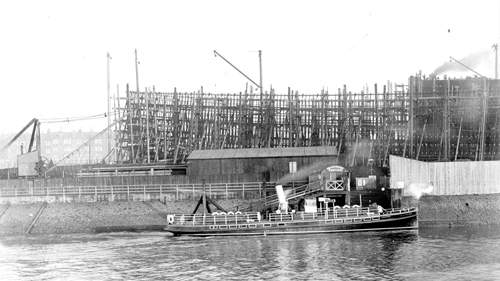Cluthas - Times Past

In partnership with the Glasgow Times our archivists are exploring Glasgow's fascinating history. This week, Barbara Neilson writes about one of Glasgow's lost public transports - the Cluthas.
The lost public transports of Glasgow are not confined to only trams and trolley buses. While our contemporary public transports are now restricted to overground or underground services like the buses, trains and subway, there once was an alternative: the river Clyde.
In April 1884, four passenger ferries began operating up and down the Clyde between Victoria Bridge and Whiteinch. Built by Thomas B. Seath & Sons of Rutherglen, each 72-foot-long ferry was sold for £2,050 to the Clyde Navigation Trust. The Trust was responsible for the widening, deepening and maintenance of the river Clyde. It also provided cross-river services including moving platform ferries at Finnieston and Whiteinch.
The passenger ferries were immensely popular and more were soon ordered to expand the service. The construction of the last six took place at Dumbarton and Port Glasgow rather than Rutherglen. By 1898, there were twelve of these ferries. Every one of them was named Clutha (an 18th century name for the Clyde) and numbered from 1 to 12. Each Clutha could carry between 230 – 350 passengers and the service was frequent at every fifteen minutes. There were ten landing stages between the city centre and Whiteinch which at that time was part of the burgh of Partick. These landing stages are named on a map of the River and Forth of Clyde (dated 1900) in our collections.
The Cluthas (as they were collectively known) drew many of their passengers from the workers who commuted to shipyards and engineering workshops along the Clyde. They were especially popular among the residents of Govan and Partick and were also a major employer of Gaelic-speaking sailors. Over their years of service, the Cluthas and their crew transported millions of passengers up and down the river. Their heyday was in 1897, a year in which three million passengers sailed with them. However, space onboard was at a premium. Passengers were crammed in and extra space was only afforded to those who could pay a bit extra. Additional onboard space included the ladies’ cabin and the smoking room.
We hold many archives relating to the Cluthas in our Clyde Navigation Trust collection including reports, statements of accounts, papers concerning trials of new ferries and photographs. Among a group photograph of the Clyde Navigation Trust Collectors department, are two former Clutha superintendents: Alexander McPherson and Robert Grieve. Elsewhere, we hold the general arrangement, profile and main deck plans for Clutha No. 1 which was built in January 1884. Several models of various Cluthas are also held among the Glasgow Museums ship models collection.
However, the rise of alternative riverside transport heralded the end of the Cluthas. When Glasgow’s tram system became electrified in 1898, it offered a cheaper and more efficient mode of transport than the Cluthas which were also competing with the city’s trains and subway services. The Cluthas soon became unprofitable and were discontinued in 1903 although the cross-river services remained.
